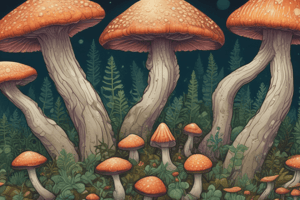Podcast
Questions and Answers
Which pathogen infects SKIN and NAILS only?
Which pathogen infects SKIN and NAILS only?
- Epidermophyton floccosum (correct)
- Trichophyton tonsurans
- Trichophyton mentagrophytes
- Trichophyton rubrum
Which pathogen produces a white, cottony surface and a deep red non-diffusible pigment when viewed from the reverse side of the colony?
Which pathogen produces a white, cottony surface and a deep red non-diffusible pigment when viewed from the reverse side of the colony?
- Trichophyton tonsurans
- Trichophyton rubrum (correct)
- Epidermophyton floccosum
- Trichophyton mentagrophytes
Which pathogen develops cylindric smooth walled macroconidia and characteristic microconidia?
Which pathogen develops cylindric smooth walled macroconidia and characteristic microconidia?
- Trichophyton tonsurans
- Trichophyton rubrum
- Epidermophyton floccosum
- Trichophyton mentagrophytes (correct)
Which pathogen produces flat, powdery to velvety colonies that become reddish brown on the reverse?
Which pathogen produces flat, powdery to velvety colonies that become reddish brown on the reverse?
Which of the following genera is known to produce multicellular macroconidia with echinulate walls?
Which of the following genera is known to produce multicellular macroconidia with echinulate walls?
In lesions, which of the following genera form septate hyphae and asexual spores with powdery and pigmented colonies?
In lesions, which of the following genera form septate hyphae and asexual spores with powdery and pigmented colonies?
Which species is known to form a colony with a white cottony surface and a deep yellow color on the reverse side, with thick-walled, 8-15 celled macroconidia with curved or hooked tips?
Which species is known to form a colony with a white cottony surface and a deep yellow color on the reverse side, with thick-walled, 8-15 celled macroconidia with curved or hooked tips?
Which of the following genera infects HAIR and SKIN only?
Which of the following genera infects HAIR and SKIN only?
Which of the following genera produce a tan, powdery colony with abundant thin-walled 4- to -6 celled macroconidia?
Which of the following genera produce a tan, powdery colony with abundant thin-walled 4- to -6 celled macroconidia?
Which genus is differentiated mainly by the nature of their macroconidia?
Which genus is differentiated mainly by the nature of their macroconidia?
Study Notes
Skin and Nail Infections
- Trichophyton infects skin and nails only.
Colony Characteristics
- Trichophyton produces a white, cottony surface and a deep red non-diffusible pigment when viewed from the reverse side of the colony.
Macroconidia Characteristics
- Microsporum develops cylindric, smooth-walled macroconidia and characteristic microconidia.
Colony Color and Macroconidia
- Microsporum produces flat, powdery to velvety colonies that become reddish brown on the reverse side.
Macroconidia Walls and Genera
- Echinococcus is known to produce multicellular macroconidia with echinulate walls.
Lesion Characteristics and Genera
- Trichophyton forms septate hyphae and asexual spores with powdery and pigmented colonies in lesions.
Colony Color and Macroconidia Shapes
- Trichophyton species form a colony with a white cottony surface and a deep yellow color on the reverse side, with thick-walled, 8-15 celled macroconidia with curved or hooked tips.
Hair and Skin Infections
- Microsporum infects hair and skin only.
Colony Color and Macroconidia Characteristics
- Epidermophyton produces a tan, powdery colony with abundant thin-walled 4- to 6-celled macroconidia.
Genera Differentiation
- Genera are differentiated mainly by the nature of their macroconidia.
Studying That Suits You
Use AI to generate personalized quizzes and flashcards to suit your learning preferences.
Description
Test your knowledge on the identification and clinical significance of Microsporum spp, Epidermophyton spp, and Trichophyton spp in dermatophyte infections, also known as ringworm or Tinea. Understand the characteristics and impact of these filamentous fungi on superficial keratinized tissues like skin, hair, and nails.




